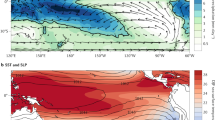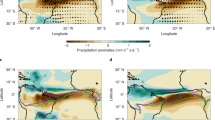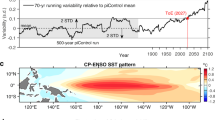Abstract
The South Pacific convergence zone (SPCZ) is the Southern Hemisphere’s most expansive and persistent rain band, extending from the equatorial western Pacific Ocean southeastward towards French Polynesia1,2. Owing to its strong rainfall gradient, a small displacement in the position of the SPCZ causes drastic changes to hydroclimatic conditions and the frequency of extreme weather events—such as droughts, floods and tropical cyclones—experienced by vulnerable island countries in the region1,2,3,4,5,6,7. The SPCZ position varies from its climatological mean location with the El Niño/Southern Oscillation (ENSO), moving a few degrees northward during moderate El Niño events and southward during La Niña events2,5,6. During strong El Niño events, however, the SPCZ undergoes an extreme swing—by up to ten degrees of latitude toward the Equator—and collapses to a more zonally oriented structure5 with commensurately severe weather impacts5,8,9,10,11. Understanding changes in the characteristics of the SPCZ in a changing climate is therefore of broad scientific and socioeconomic interest. Here we present climate modelling evidence for a near doubling in the occurrences of zonal SPCZ events between the periods 1891–1990 and 1991–2090 in response to greenhouse warming, even in the absence of a consensus on how ENSO will change12,13,14. We estimate the increase in zonal SPCZ events from an aggregation of the climate models in the Coupled Model Intercomparison Project phases 3 and 5 (CMIP315 and CMIP5) multi-model database that are able to simulate such events. The change is caused by a projected enhanced equatorial warming in the Pacific16 and may lead to more frequent occurrences of extreme events across the Pacific island nations most affected by zonal SPCZ events.
This is a preview of subscription content, access via your institution
Access options
Subscribe to this journal
Receive 51 print issues and online access
$199.00 per year
only $3.90 per issue
Buy this article
- Purchase on Springer Link
- Instant access to full article PDF
Prices may be subject to local taxes which are calculated during checkout




Similar content being viewed by others
References
Kiladis, G. N., Storch, H. V. & Loon, H. V. Origin of the South Pacific Convergence Zone. J. Clim. 2, 1185–1195 (1989)
Vincent, D. G. The south Pacific convergence zone (SPCZ): a review. Mon. Weath. Rev. 122, 1949–1970 (1994)
Salinger, M. J., Renwick, J. A. & Mullan, A. B. Interdecadal Pacific oscillation and South Pacific climate. Int. J. Climatol. 21, 1705–1721 (2001)
Kumar, V. V., Deo, R. C. & Ramachandran, V. Total rain accumulation and rain-rate analysis for small tropical Pacific islands: a case study of Suva, Fiji. Atmos. Sci. Lett. 7, 53–58 (2006)
Vincent, E. M. et al. Interannual variability of the South Pacific Convergence Zone and implications for tropical cyclone genesis. Clim. Dyn. 36, 1881–1896 (2011)
Folland, C. K., Renwick, J. A., Salinger, M. J. & Mullan, A. B. Relative influence of the interdecadal Pacific oscillation and ENSO on the South Pacific Convergence Zone. Geophys. Res. Lett.. 29, 1643, http://dx.doi.org/10.1029/2001GL014201 (2002)
Hennessy, K. Power, S. & Cambers, G. (eds) Climate Change in the Pacific: Scientific Assessment and New Research Vol. 1, Regional Overview; Vol. 2, Country Reports (Australian Bureau of Meteorology and CSIRO, 2011)
Barnett, J. Dangerous climate change in Pacific Islands: food production and food security. Reg. Environ. Change 11, 229–237 (2011)
Glynn, P. Widespread coral mortality and the 1982–83 El Niño warming event. Environ. Conserv. 11, 133–146 (1984)
Hoegh-Guldberg, O. Climate change, coral beaching and the future of the world’s coral reefs. Mar. Freshwat. Res. 50, 839–866 (1999)
Mumby, P. J. et al. Unprecedented bleaching-induced mortality in Porites spp. at Rangiroa Atoll, French Polynesia. Mar. Biol. 139, 183–189 (2001)
Guilyardi, E. et al. Understanding El Niño in ocean–atmosphere general circulation models: progress and challenges. Bull. Am. Meteorol. Soc. 90, 325–340 (2009)
Collins, M. et al. The impact of global warming on the tropical Pacific Ocean and El Niño. Nature Geosci. 3, 391–397 (2010)
Ashok, K., Sabin, T. P., Swapna, P. & Murtugudde, R. G. Is a global warming signature emerging in the tropical Pacific? Geophys. Res. Lett. 39, L02701, http://dx.doi.org/10.1029/2011GL050232 (2012)
Meehl, G. et al. The WCRP CMIP3 multimodel dataset: a new era in climate change research. Bull. Am. Meteorol. Soc. 88, 1383–1394 (2007)
Xie, S. P. et al. Global warming pattern formation: sea surface temperature and rainfall. J. Clim. 23, 966–986 (2010)
Takahashi, K. & Battisti, D. S. Processes controlling the mean tropical Pacific precipitation pattern. Part II: the SPCZ and the southeast Pacific dry zone. J. Clim. 20, 5696–5706 (2007)
Lehodey, P., Bertignac, M., Hampton, J., Lewis, A. & Picaut, J. El Niño Southern Oscillation and tuna in the western Pacific. Nature 389, 715–718 (1997)
Cane, M. A. et al. Twentieth-century sea surface temperature trends. Science 275, 957–960 (1997)
Vecchi, G. A. et al. Weakening of tropical Pacific atmospheric circulation due to anthropogenic forcing. Nature 441, 73–76 (2006)
Yeh, S.-W. et al. El Niño in a changing climate. Nature 461, 511–514 (2009)
Ashok, K., Behera, S. K., Rao, S. A., Weng, H. & Yamagata, T. El Niño Modoki and its possible teleconnection. J. Geophys. Res.. 112, C11007, http://dx.doi.org/10.1029/2006JC003798 (2007)
Brown, J. R., Moise, A. F. & Delage, F. P. Changes in the South Pacific Convergence Zone in IPCC AR4 future climate projections. Clim. Dyn. 39, 1–19 (2012)
Lorenz, E. N. Empirical Orthogonal Functions and Statistical Weather Prediction (Statistical Forecast Project Rep. 1, Department of Meteorology, MIT, 1956)
Adler, R. F. et al. The version 2 Global Precipitation Climatology Project (GPCP) monthly precipitation analysis (1979-present). J. Hydrometeorol. 4, 1147–1167 (2003)
Austin, P. C. Bootstrap methods for developing predictive models. Am. Stat. 58, 131–137 (2004)
Spencer, H. Role of the atmosphere in seasonal phase locking of El Niño. Geophys. Res. Lett. 31, L24104, http://dx.doi.org/10.1029/2004GL021619 (2004)
Lengaigne, M., Boulanger, J. P., Menkes, C. & Spencer, H. Influence of the seasonal cycle on the termination of El Niño events in a coupled general circulation model. J. Clim. 19, 1850–1868 (2006)
Liu, Z., Vavrus, S., He, F., Wen, N. & Zhong, Y. Rethinking tropical ocean response to global warming: the enhanced equatorial warming. J. Clim. 18, 4684–4700 (2005)
Timmermann, A., McGregor, S. & Jin, F.-F. Wind effects on past and future regional sea level trends in the southern Indo-Pacific. J. Clim. 23, 4429–4437 (2010)
Acknowledgements
This work was supported by the Australian Climate Change Science Program, CSIRO Office of Chief Executive Science Leader programme, and the Pacific-Australia Climate Change Science and Adaptation Planning Program. A.T. and M.J.W. were supported by the Office of Science (BER) US Department of Energy, grant DE-FG02-07ER64469, the US National Science Foundation under grant 1049219 and by the Japan Agency for Marine-Earth Science and Technology (JAMSTEC). M.J.M. was supported by NOAA and by CSIRO as a visiting scholar. M.L., C.M. and E.M.V. were supported by the Institut de Recherche pour le Développement (IRD). This is PMEL contribution number 3830.
Author information
Authors and Affiliations
Contributions
W.C. and M.L. conceived the study, directed the analysis and wrote the initial draft of the paper. S.B. performed the analysis. M.C. conducted the perturbed physics ensemble climate change experiments with the HadCM3 model. All authors contributed to interpreting results, discussion of the associated statistical significance, and improvement of the paper.
Corresponding author
Ethics declarations
Competing interests
The authors declare no competing financial interests.
Supplementary information
Supplementary Information
This file contains Supplementary Figures 1-10, Supplementary Tables 1-5 and Supplementary References. (PDF 1190 kb)
Rights and permissions
About this article
Cite this article
Cai, W., Lengaigne, M., Borlace, S. et al. More extreme swings of the South Pacific convergence zone due to greenhouse warming. Nature 488, 365–369 (2012). https://doi.org/10.1038/nature11358
Received:
Accepted:
Published:
Issue Date:
DOI: https://doi.org/10.1038/nature11358
This article is cited by
-
Dominant contribution of atmospheric nonlinearities to ENSO asymmetry and extreme El Niño events
Scientific Reports (2024)
-
Fire activity and deforestation in Remote Oceanian islands caused by anthropogenic and climate interactions
Nature Ecology & Evolution (2023)
-
Anthropogenic impacts on twentieth-century ENSO variability changes
Nature Reviews Earth & Environment (2023)
-
Extreme events in the multi-proxy South Pacific drought atlas
Climatic Change (2023)
-
Recent ocean acidification trends from boron isotope (δ11B) records of coral: Role of oceanographic processes and anthropogenic CO2 forcing
Journal of Earth System Science (2022)
Comments
By submitting a comment you agree to abide by our Terms and Community Guidelines. If you find something abusive or that does not comply with our terms or guidelines please flag it as inappropriate.



